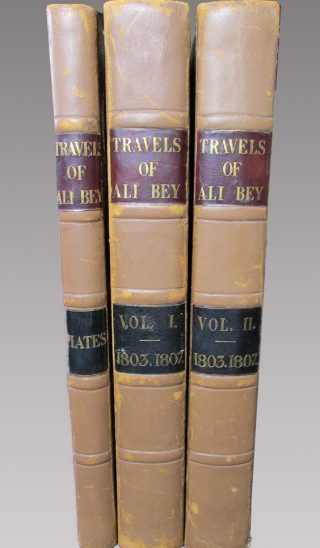Travels of Ali Bey in Morocco, Tripoli, Cyprus, Egypt, Arabia, Syria & Turkey, between The Years 1803-1807, written by Himself. TWO VOLUMES OF TEXT + ONE ATLAS VOLUME OF PLATES.
Badia Y. Leblich, Domingo. "Ali Bey", 1766-1818.
Synopsis
The Atlas contains three large folding maps: North Africa, Asia Minor and Arabia and the Red Sea. Plus three large folding plates: Plate 72 in two parts of El-Sahara and one plate of El-Aksa.
Badia y Leblich was a Spanish traveller who assumed the name Ali Bey el Abbassi and disguised himself as an Arab. He seems to have been travelling as an agent of the Spanish government. In 1803 he departed for Tangier and travelled through North Africa to Egypt, where he met de Chateaubriand (a French Romantic writer, diplomat, historian and politician) in Alexandria. He continued to Cyprus and reached Mecca by the beginning of 1807, returning via Jerusalem, Damascus and Constantinople to Spain the same year. He joined the Napoleonic forces in the invasion of Spain, was forced to withdraw with them to France after their expulsion from the Peninsula, and was resident in Paris by 1813, which accounts for the fact that the first edition of this work was printed there. He was commonly reported to have been a spy in the service of Napoleon. Ali Bey el Abbassi was the first Christian to describe in some detail Mecca, and the Mosque of Omar in Jerusalem, as well as some lesser known aspects of Islam. After the publication of this work he planned a second journey under the name Ali Othman and returned to Syria, where he died suddenly in Aleppo, apparently after having been found out. The plates in this work are mostly after designs by Ali Bey himself and include architectural plans, subjects on natural history and views of different subjects.
Modern scholars have demonstrated that he was actually very much involved in the complex Spanish political events in the period of 1808-10 of the Peninsular War.
Bibliographic references: Blackmer 62; Gay 81; Hilmy I, 30; Palau, 21683; Tobler, 140; Brunet I, 182-3; Macro 451; Playfair, Morocco,
506; Rohricht 1607 for the French edition.






